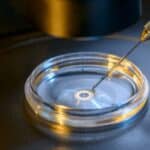Pretty cool breakthrough:
MONDAY, Nov. 10 (HealthDay News) — Stem cells collected at birth from the umbilical cord may help doctors fashion new heart valves for children born with heart valve defects.
The tissue-engineered valves would have the advantage of growing with the child, the German researchers said.
“If we replace a valve in a child, they will need surgery several times in their lifetime, because they will grow out of the devices, so the ultimate goal is to have a construct which is able to grow with the child and only have to do the surgery once,” said study author Dr. Ralf Sodian, a cardiac surgeon at University Hospital of Munich. “Earlier is better, if it’s possible.”
Presenting Monday at the American Heart Association’s annual scientific sessions in New Orleans, Sodian reported that his team took stem cells from umbilical cord blood, stored them for 12 weeks, then seeded them on to eight heart valve scaffolds.
The stem cells went on to form a layer of tissue which included several characteristics of the “extracellular matrix,” or the section of tissue outside of cells.
The engineered valves had almost 78 percent as much collagen as human tissue from pulmonary heart valves; 85 percent as much glycosaminoglycan as human tissue; and 67 percent as much elastin. Collagen and elastin are proteins in connective tissue, and glycosaminoglycan is a carbohydrate in connective tissue.
The valves also contained other proteins found in the human body.
“The whole idea of building a scaffold is a unique idea,” said AHA spokesman Dr. Russell V. Luepker, the Mayo professor of epidemiology and community health at the University of Minnesota in Minneapolis. “We generally put progenitor cells in the heart and try to get them to grow muscle cells, and they’re sitting in the middle of other cells.”
“But to build a scaffold that looks like a heart valve then hope and anticipate that the cord blood cells will take that hint and differentiate, I think is very innovative,” he added.
Still, the research is a long way from clinical practice.
“I don’t think anyone has any idea if [these valves] would grow,” Luepker said. “One may not know until it is put into a child, and the child grows. There are obviously a lot of hurdles to overcome.”
Malfunctioning heart valves in babies that can’t be surgically repaired are replaced with valves made from animal tissue, other human tissue or man-made materials.
Because these valves don’t grow with the child, more surgeries for new valves are often needed.
There is also a possibility that the child’s body will reject the artificial valve, although this is not so common, Luepker said.
A bigger issue is the sheer work that a heart valve has to perform. “The stresses on a heart valve are enormous,” Luepker said. “They have to hold the blood back with each beat. The wear and tear on them which we see with metal and plastic valves is an issue, and those are fairly hard substances.”
Author Profile

- Jennifer Lahl, MA, BSN, RN, is founder and president of The Center for Bioethics and Culture Network. Lahl couples her 25 years of experience as a pediatric critical care nurse, a hospital administrator, and a senior-level nursing manager with a deep passion to speak for those who have no voice. Lahl’s writings have appeared in various publications including Cambridge University Press, the San Francisco Chronicle, the Dallas Morning News, and the American Journal of Bioethics. As a field expert, she is routinely interviewed on radio and television including ABC, CBS, PBS, and NPR. She is also called upon to speak alongside lawmakers and members of the scientific community, even being invited to speak to members of the European Parliament in Brussels to address issues of egg trafficking; she has three times addressed the United Nations during the Commission on the Status of Women on egg and womb trafficking.
Latest entries
 infertilityApril 23, 2024The Rise of International Gestational Surrogacy in the U.S.
infertilityApril 23, 2024The Rise of International Gestational Surrogacy in the U.S. Assisted Reproductive TechnologyApril 16, 2024Founder Jennifer Lahl’s Speech on Surrogacy to the Casablanca Declaration
Assisted Reproductive TechnologyApril 16, 2024Founder Jennifer Lahl’s Speech on Surrogacy to the Casablanca Declaration #BigFertilityFebruary 27, 2024No, Alabama Didn’t Ban IVF
#BigFertilityFebruary 27, 2024No, Alabama Didn’t Ban IVF ArticleSeptember 25, 2023The Little Engine That Could
ArticleSeptember 25, 2023The Little Engine That Could

